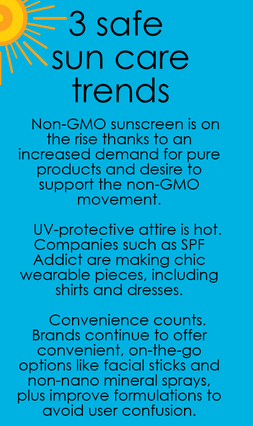Lessons from top-rated mineral sun care brands
Now in its 10th year, the Environmental Working Group's Guide to Sunscreens rates sun care products on safety and efficacy. Here, top-rated mineral brands weigh in on trends and opportunities in safe sun care.

Some things are constant: Warmer, sunnier weather leads to a seasonal surge in consumers scrambling to grab for products that will help protect them from the rays. What is changing: the state of the sun care market, which was illuminated by the Environmental Working Group's 10th annual Guide to Sunscreens.
The guide assesses product efficacy, rating hundreds of products on a scale of 1 to 10 (1 being the safest; 10 being the most hazardous). To support the report, the EWG unites manufacturers and retailers to develop safe sun care awareness initiatives. “We have a sun safety campaign that works with sunscreen companies on getting the message out about the big picture of sun protection,” says Sonya Lunder, EWG senior analyst. And the big picture is evolving, according to Lunder.
A changing sun care market
Good news first: As consumers become more aware of the importance of sunscreen and of ingredient integrity, there has been significant growth in the number of sunscreens using active mineral ingredients zinc oxide and titanium oxide. Zinc oxide—when used at correct concentrations—is the most effective ingredient for full-spectrum coverage, the EWG reports.
Mineral products represented 17 percent of sunscreens back in 2007 when the EWG released its first report; that percentage doubled to 34 in this year’s report. “We are seeing more mineral sunscreens and more smaller companies; new growth in that sector,” Lunder says.
On the not-so bright side, the report also revealed that nearly 75 percent of the beach and sport sunscreens investigated either contained concerning ingredients such as oxybenzone, or offered inferior protection from the sun—mainly inadequate UVA protection. (A product’s SPF value indicates only how successfully it is at blocking from UVB rays, which cause sunburn; however, many products don’t offer the same protection from UVA rays, due in part to lax required testing standards.) In a new section for this year’s report, the EWG also found that many kids' products ranked poorly in the safety department. Such inadequacies are a result of formulation and marketing issues, which some companies are facing head on.
Tackling formulation challenges
While zinc oxide and titanium dioxide offer superior broad-spectrum protection, Lunder points out that these products, too, face challenges. One common pitfall: too low concentrations of minerals. For example, a zinc product making SPF 30 claims should contain 20 percent zinc oxide, according to Stacey Egide, CEO at Andalou Naturals (this is where the Honest Company went wrong last year).
 When it comes to SPF values, there’s another issue: the use of sky-high numbers, which can be inaccurate and misleading. Many companies, both mineral and chemical, are making potentially unsubstantiated and extremely high SPF claims. In this year’s report, more mineral SKUs were following suit, Lunder notes. Other companies may be using antioxidant or anti-inflammatory ingredients to mask sunburns, as opposed to actually protecting from other harmful UV rays.
When it comes to SPF values, there’s another issue: the use of sky-high numbers, which can be inaccurate and misleading. Many companies, both mineral and chemical, are making potentially unsubstantiated and extremely high SPF claims. In this year’s report, more mineral SKUs were following suit, Lunder notes. Other companies may be using antioxidant or anti-inflammatory ingredients to mask sunburns, as opposed to actually protecting from other harmful UV rays.
“There’s this question about a product having a high SPF value but not protecting you from other UV damage,” Lunder says. Many of these ingredients tend to be natural botanicals, which can perpetuate the impression that the product is safer or more effective. “Since the human tests only measure sunburn, we are concerned these higher SPF values may be using ingredients that do not have protection across the UV spectrum," she says.
Companies such as W.S. Badger Company, however, are tackling this problem head on: The Badger team recognizes the limitations of current testing and has developed more sophisticated ways to ensure that their products get the job done. “We are using new testing, not even required by the FDA, to make sure we had a really solid system that’s natural but also works,” according to Rebecca Hamilton, Badger’s vice president of research and development.
Opportunities for natural sun care brands
Beyond focusing on broad-spectrum UV protection, Badger is also looking at advancing other aspects of product formulation to take mineral sun care to that next level. “An innovation for us is the preservative system in natural sunscreen, which has always been a challenge," Hamilton says. “Mineral sunscreens in particular have a high pH, so even normal natural preservatives don’t work as well. Most sunscreens go to petroleum-derived synthetic preservatives.”
This relates to an overall shift towards cleaner, safer, purer products, she says. The demand for purity and simplicity is one reason there’s been an increase in non-GMO verified sunscreens. Badger received its seal of approval from NSF’s new non-GMO standard.
For Jersey Shore Cosmetics Founder Jacquelyn Quattro, the biggest challenge and opportunity in sun care is consumer education. The company, which was rated among the safest products in this year’s report, continues to focus on helping consumers understand common misconceptions about sun care and how to use a product. “Many other brands use chemicals, which makes their sunscreens sheer, or transparent, which is attractive to the mainstream consumer,” Quattro says. “We have had to convince the consumers that a safe sunscreen which is a little opaque, is a smarter choice.” In many instances, this means taking a few extra moments to blend the mineral sunscreen in. But, “it’s worth it,” she notes.
Safe sun care communication: What’s your message?
Lunder agrees that continued consumer education is key to affecting industry change. But how can you distill an often-confusing message into consumer-friendly language? The EWG works with brands and retailers to develop communication strategies that will help keep customers informed on the complicated sun care category. Lunder says the message should start with three key points:
Encourage customers to try mineral sunscreens that use zinc oxide and zinc titanium dioxide for top efficacy.
Avoid SPF values above 50, because they are misleading and can be misused.
Understand the limitations of sunscreen and that covering your skin, wearing a hat and wearing glasses is going to be more stable.
About the Author(s)
You May Also Like




